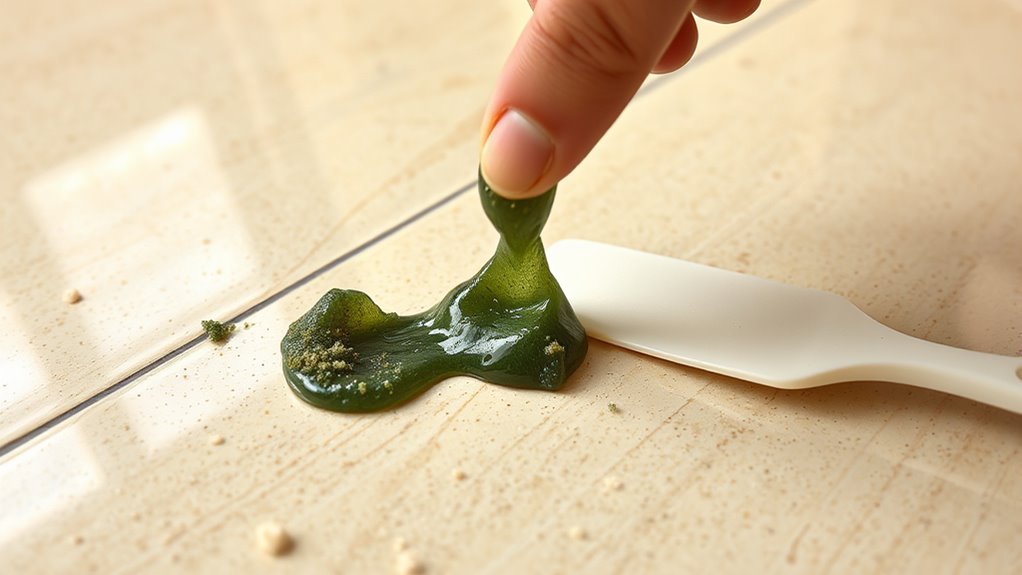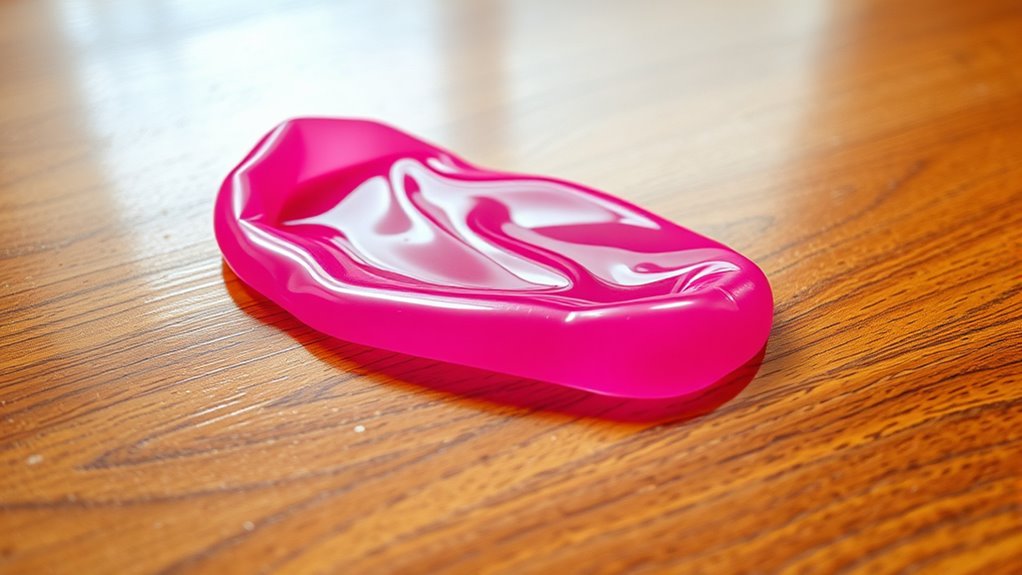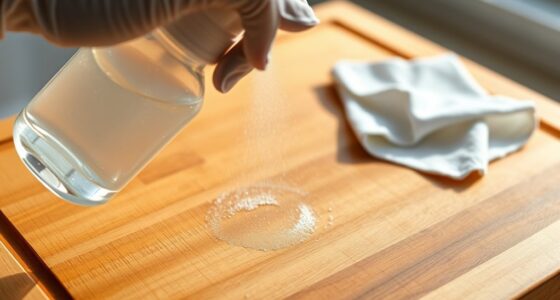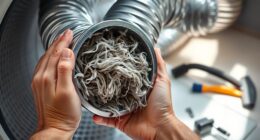To remove chewing gum from hard floors, start by applying ice cubes directly onto the gum to harden it. Once solid, gently lift the gum with a plastic scraper, being careful not to scratch the surface. If residue remains, use a cleaning solution like vinegar or a commercial adhesive remover, letting it sit a few minutes before wiping away. Patience is key—if you keep going, you’ll discover even more effective tips for a spotless floor.
Key Takeaways
- Harden the gum by applying ice cubes directly to make it brittle and easier to lift.
- Gently scrape the hardened gum with a plastic putty knife to avoid damaging the floor.
- Use a cleaning solution like vinegar diluted in water or a commercial adhesive remover to break down residual stickiness.
- Dampen a cloth with the cleaning solution and scrub the area to remove leftover adhesive residue.
- Dry the area thoroughly and clean with a mop or microfiber cloth for a spotless finish.

Getting Chewing Gum Off Hard Floors
Chewing gum stuck on hard floors can be a frustrating problem, but with the right approach, you can remove it quickly and effectively. The first step is understanding the types of adhesives you’re dealing with. Chewing gum is a sticky, rubbery substance, but other adhesives like glue, tape residue, or sticker adhesive can also cause similar messes on your floors. Recognizing the specific type of adhesive helps you choose the right cleaning tools and methods. For gum, the goal is to harden it so it can be lifted easily. For other adhesives, you might need solvents or specialized tools.
Understanding different adhesives helps you choose the right tools for effective cleaning.
To get started, gather some basic cleaning tools you’ll use throughout the process. A plastic putty knife or a similar plastic scraper works well because it won’t scratch your floor’s surface. You’ll also want some ice cubes, a soft cloth or paper towels, and possibly a commercial adhesive remover if needed. For stubborn residues, a gentle solvent like rubbing alcohol or vinegar can be effective, but always test a small area first to avoid damaging the finish.
Next, apply ice cubes directly onto the gum or sticky adhesive. This cools and hardens the substance, making it easier to break free. Use a plastic scraper to gently lift the hardened gum or adhesive from the floor. Avoid metal tools, which can scratch or damage the surface. If the gum resists, reapply ice and wait a few minutes before trying again. Once you’ve lifted most of it, some residue might remain. Here, you can use a cleaning solution—either a commercial adhesive remover or a natural alternative like vinegar diluted with water. Dampen a cloth with your chosen solution and gently scrub the area.
Additionally, understanding the role of patience in the cleaning process can significantly improve your results, especially with stubborn residues. For stubborn spots, patience is key. Let the solution sit for a few minutes to loosen any remaining adhesive. Then, use the scraper again if needed, followed by wiping with a clean, damp cloth to remove any residue. In cases where the adhesive is particularly tough, you might consider a commercial adhesive remover designed for flooring. Always follow the manufacturer’s instructions and ensure good ventilation in the area.
Finally, dry the area thoroughly to prevent slips or further residue buildup. Regular cleaning tools, like a microfiber cloth or mop, can help maintain your floors and prevent future issues. By understanding the different types of adhesives and having the right cleaning tools at hand, you’ll be able to handle gum and sticky residues efficiently, keeping your floors clean and damage-free.
Frequently Asked Questions
Can I Use Hot Water to Remove Gum From Hard Floors?
Yes, hot water can help with gum removal from hard floors. You should pour or soak a cloth in hot water and hold it on the gum for a few minutes to soften it. Once the gum becomes pliable, you can gently scrape it off with a plastic scraper or cloth. Be careful not to damage the floor, and repeat the process if necessary for stubborn spots.
Will Scraping Damage My Hardwood Flooring When Removing Gum?
Scraping gum off your hardwood floor can pose some scraping risks, but if you’re careful, floor damage is unlikely. Use a plastic scraper, apply gentle pressure, and work slowly to avoid scratches. You might worry about damaging the finish, but gentle scraping with the right tools minimizes risks. Always test in a small area first, and consider softening the gum with heat or oil to make removal smoother without harming your floor.
Are Natural Remedies Effective for Gum Removal on Tiles?
Natural remedies can be effective for gum removal on tiles while ensuring tile safety. You might try freezing the gum with ice cubes, which hardens it, making it easier to peel off without damaging the surface. Alternatively, applying a small amount of vinegar or peanut butter can loosen the gum. Always test these remedies on a small, hidden area first to confirm they won’t harm your tiles.
How Long Should I Wait Before Attempting to Pick off Hardened Gum?
Like waiting for a knight to arrive, you should wait about 15-20 minutes before trying to pick off hardened gum. This drying time allows the gum to become brittle, making removal easier. Patience is required, so resist the urge to rush. Test a small area first, and gently lift the gum once it feels firm. Rushing could smudge or spread the gum, making cleanup more challenging.
Is It Safe to Use Commercial Adhesive Removers on Sealed Floors?
Using commercial adhesive removers on sealed floors can be risky because they might damage the floor’s finish or compromise its safety. Always check the product label to verify it’s safe for sealed surfaces, and test it in a small, hidden area first. If you’re unsure, consult the floor manufacturer or opt for gentler methods to maintain your floor’s safety and appearance without risking damage.
Conclusion
Now that you know how to remove chewing gum from hard floors, you’re all set to tackle sticky situations confidently. Did you know that the average person steps on over 2,000 pieces of gum in their lifetime? That’s like walking through a small city of sticky surprises! With these quick tips, you can keep your floors spotless and gum-free, saving time and effort. Stay prepared and keep your floors looking pristine, no matter what sticky mess comes your way.










